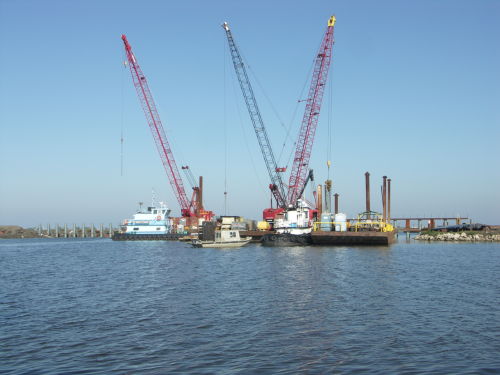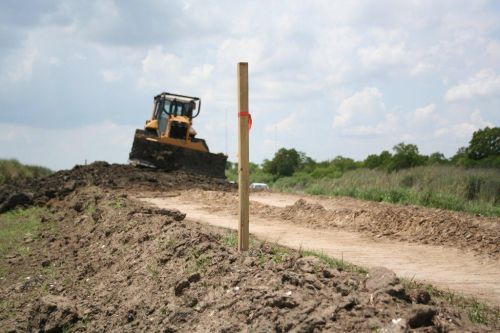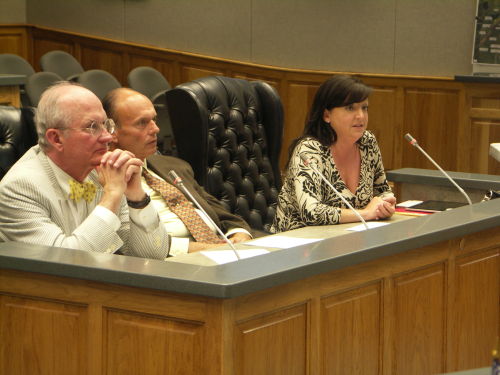
Lafourche extension doesn’t ease long-term concern
April 10, 2013
Local company prides itself on Morganza work
April 10, 2013You can personally own a piece of the biggest investment Terrebonne Parish has ever made to protect itself from floods, for as little as $5,000.
If the big boys don’t snatch it all up first.
Bonds that will pay for Terrebonne’s Morganza levee and gate system, totaling $100 million in face value, will go on sale within the next two months.
They are backed by the half-cent sales tax voters approved last year, backed by the full faith and credit of Terrebonne Parish.
While engineers and architects work out the details for how dirt, steel and other substances you can touch and see will be employed to protect the parish from future floods, a different type of architecture – which nobody really gets to see – is required to make the sale run smoothly. That work is performed by stock traders, attorneys and financial planners, all of whose efforts make the bond sale work.
“Right now, the interest rates are very favorable, among the best they have been since World War II,” said Terrebonne Levee and Conservation Board Director Reggie Dupre. “ The tax will raise $12 million a year, with a $1 million per month obligation. The bond sale will be done this month and we would get the cash at the end of May or first week in June.”
The maximum life of the bonds will be 25 years. With the money in hand, Dupre said, permits will be applied for.
The financial muscle behind the bond deal starts with a New Orleans attorney, Jerry Osborne, who has been in the bond business for 48 years and has handled many of Terrebonne’s financial obligations.
“There is no secret to borrowing $100 million,” said Osborne, a partner in the firm of Foley & Judell. “I am going to help them borrow the $100 million payable from the half-cent sales tax. Now they are ready to build those levees.”
The way Osborne explains it, getting $100 million for your local government bonds is not unlike getting a mortgage for your house.
One bank can easily handle a typical mortgage, based on your credit-worthiness and other factors. But cost of building a levee system that protects a whole parish requires a lot more help.
“One bank doesn’t necessarily have $100 million to lend and certainly not to one individual,” Osborne explained.
So the bonds help spread the financial weight out among many investors, some of whom may buy them in blocks or – if they could get them from the market in time – even individually. The minimum bond buy-in is $5,000.
“We divide up the loan among 50 different people or 80 different people,” Osborne said. “They all get pieces of paper in return for the money they lend us and they are called bonds. They could be called other things, a note or a warrant certificate. But the word we put at the top is bond because your word is your bond. You are really serious that you are going to repay them. If the investor lends us $50,000 then they get back $50,000 plus interest.”
How much interest gets paid will vary, depending on whether the bond is bought long-term or short-term. The interest rate for the Levee District bonds has not yet been determined.
Bringing the bonds to market will be the firm of Raymond James & Associates. Houma financial planner John Sirois, who specializes in financing specific to Louisiana is quite familiar with the bond issue.
“We take pre-orders for the bonds,” Sirois said. “Orders can be made prior to an offering to the general public. We take orders and t hey may sell out.”
When that happens the bonds could end up on what is called the secondary market, bought and sold by individuals, corporations or banks.
Your own retirement fund may have all or some of your investment in municipal bonds, which is the category the Levee District bonds fall into.
They are generally regarded as low risk, said Sirois, whose book, Louisiana Retirement and Estate Planning, includes detailed information on how such investments affect individual portfolios, particularly those related to the state or its subdivisions.
While not generally thought of as part of the levee process, Sirois, Osborne and other professionals say they are aware of their unique role in helping keep Terrebonne dry.
“The best part of my job is to drive down the street and say look at that school, I helped finance it,” Osborne said. “Or look at that drainage project, I helped finance that.”
New Orleans attorney Jerry Osborne, Terrebonne Levee and Conservation Board Director Reggie Dupre and TLCB’s Angela Reins address the Terrebonne Parish Council in this file photo. According to Osborne, the parish is undertaking its largest bond issue ever – $100 million – to fund work on Morganza.












